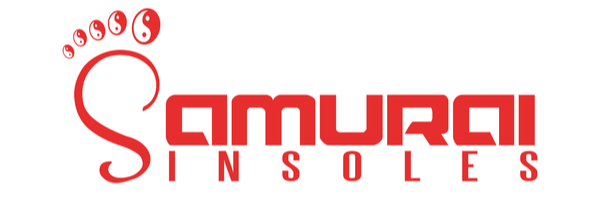If you’ve ever felt that sharp, stabbing pain in your heel when you first get out of bed, you know what plantar fasciitis is all about. While there are a lot of ways to tackle it, I’ve found that targeted massage is one of the most powerful tools for real, lasting relief. It's about more than just rubbing the sore spot; it’s about understanding how to release tension in connected areas, like your calves, which is often the secret to getting back on your feet for good.
Why Massage Works Wonders for Heel Pain
Living with plantar fasciitis is a grind. It can turn simple things, like a morning walk to the kitchen, into a painful journey. The culprit is the plantar fascia, that thick band of tissue running from your heel to your toes. When it gets inflamed and angry, every step feels like you're walking on glass.
To see why massage is so effective, you have to look at the bigger picture. You can learn more about what is plantar fasciitis and its causes in our detailed guide, but the short story is that massage helps by attacking the problem from a few different angles. It’s not just a temporary fix; it's about making real changes in the tissue to help it heal.
What’s Happening Under the Skin
When you apply focused pressure to the arch of your foot and the muscles around it, you kickstart a few key healing processes.
-
Boosting Blood Flow: Massaging the area gets the blood moving. This brings fresh oxygen and nutrients right to the damaged fascia, which is exactly what it needs to repair itself. It also helps clear out the waste products that cause inflammation.
-
Breaking Up Scar Tissue: Over time, chronic irritation can create little knots of scar tissue, or adhesions. These make your foot feel stiff and inflexible. Techniques like cross-fiber friction work to break up these adhesions, helping restore your foot's natural movement and reduce that tight, pulling sensation.
-
Easing Muscle Tension: Here’s a big one: The problem often starts higher up the leg. Tight calf muscles and a tense Achilles tendon are constantly yanking on your heel bone. This puts the plantar fascia under non-stop strain. A good calf massage can relieve that tension, taking a huge load off your foot.
The pain from plantar fasciitis isn't just a foot problem; it's a symptom of a larger kinetic chain issue. Releasing tension in your calves is just as important as massaging your arch.
A Proven Path to Relief
If you're dealing with this, you're in good company. Plantar fasciitis affects about 1 in 10 people at some point in their lives. The good news? The vast majority of people get better without surgery.
Research consistently shows that conservative treatments work, with methods like deep tissue massage successfully resolving about 90% of cases. This makes learning the right massage techniques a game-changer. When you understand why it works, you can apply the methods in this guide with more confidence and finally start your journey to becoming pain-free.
Hands-On Massage Techniques You Can Do Right Now
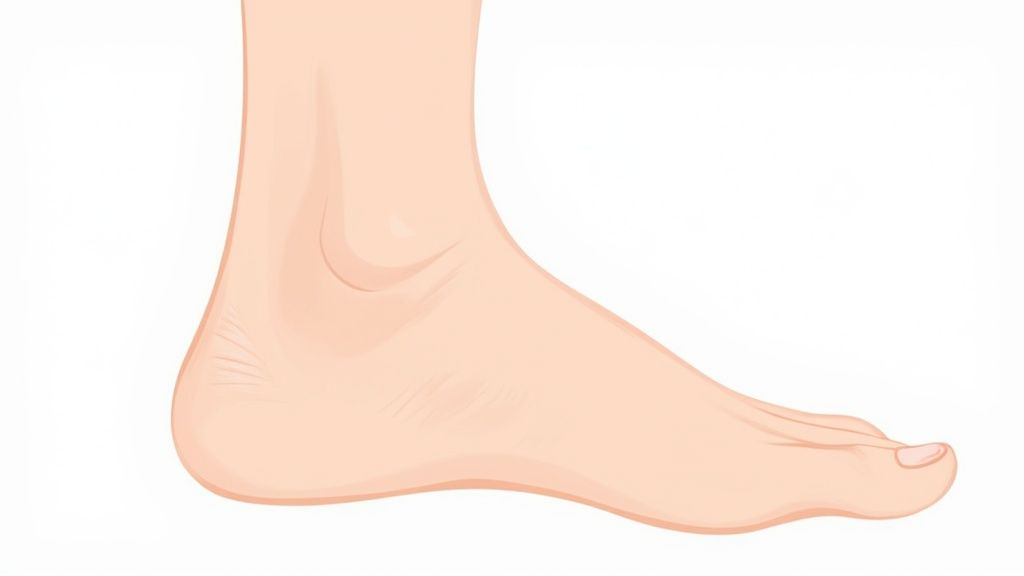
Alright, let's get right into the good stuff—the actual massage techniques you can use to start feeling better today. The secret isn't just about rubbing your foot; it's about applying the right kind of pressure and motion to kickstart healing without making things worse.
Before you even think about starting, I highly recommend warming up the area first. Just a quick five-minute foot soak in warm water or doing some gentle ankle circles gets the blood flowing. This makes the plantar fascia much more pliable and ready for the massage.
The Gentle Heel-to-Toe Glide
This is your foundational move, the one you'll probably start with every time. Think of it as gently ironing out that tight, angry band of tissue running along the bottom of your foot. It's perfect for stretching the entire plantar fascia from your heel bone right up to your toes.
First, get comfortable. Sit in a chair and cross your sore foot over the opposite knee. A little bit of lotion or massage oil will help your thumbs move smoothly without catching on your skin.
Start with both thumbs at the base of your heel. Apply a firm, steady pressure and slowly glide them up the sole of your foot, moving toward the ball and your toes. Make sure you cover the whole width of your arch. Go for about 5-10 passes. The pressure should feel deep and satisfying, but never sharp or excruciating.
Pro-Tip: As you do this, really focus on the feeling of lengthening the tissue. I sometimes picture smoothing out a wrinkled piece of fabric. This little mental trick can help you maintain consistent, effective pressure through the whole movement.
Mastering Cross-Fiber Friction
While the glide works along the fascia, this next technique works across it. From my experience, this is one of the most powerful ways to break down the stubborn scar tissue and adhesions that are making your foot so stiff.
Find the tightest, most rope-like bands in your arch. Using one thumb or a couple of fingertips, press firmly into that tissue. Now, instead of gliding up your foot, you're going to scrub back and forth across the grain of the fascia.
It's a bit like strumming a thick guitar string. The movement is small and very targeted. Focus on one tender spot for 15-20 seconds before you move on to the next one. This technique can feel pretty intense, so remember to breathe through it and listen to your body.
- Where to Focus: The inner arch is usually the thickest and most painful area, so give it some extra attention.
- Pressure Gauge: You're aiming for that "good hurt"—a deep, releasing sensation. If you feel any sharp, shooting pain, back off immediately.
- Consistency is Key: A few minutes of this every day can make a world of difference in your flexibility over time.
This specific motion directly tackles the fibrous knots that are restricting your foot's movement, helping to ease that awful pulling sensation at your heel.
Targeted Thumb Presses for Knots
Last but not least, we have targeted pressure for those nasty little trigger points. These are the small, extra-sensitive "knots" that can shoot pain across your arch and into your heel.
Carefully explore the bottom of your foot with your thumb until you find one of those exquisitely tender spots. Once you’ve zeroed in on one, apply direct, steady pressure and just hold it. Don't move your thumb around—just press and hold for 30-60 seconds.
You should feel the tension in that little knot start to melt away. Don’t press so hard that you’re wincing or tensing up your whole body; that defeats the purpose. The goal is to gently coax the muscle to let go.
After you feel a release, move on and hunt for the next spot. You'll likely find several, especially along the arch and near the heel. This is the perfect way to finish your massage, cleaning up any lingering tight spots you found during the glides and friction work.
Using Simple Tools for Deeper Heel Pain Relief
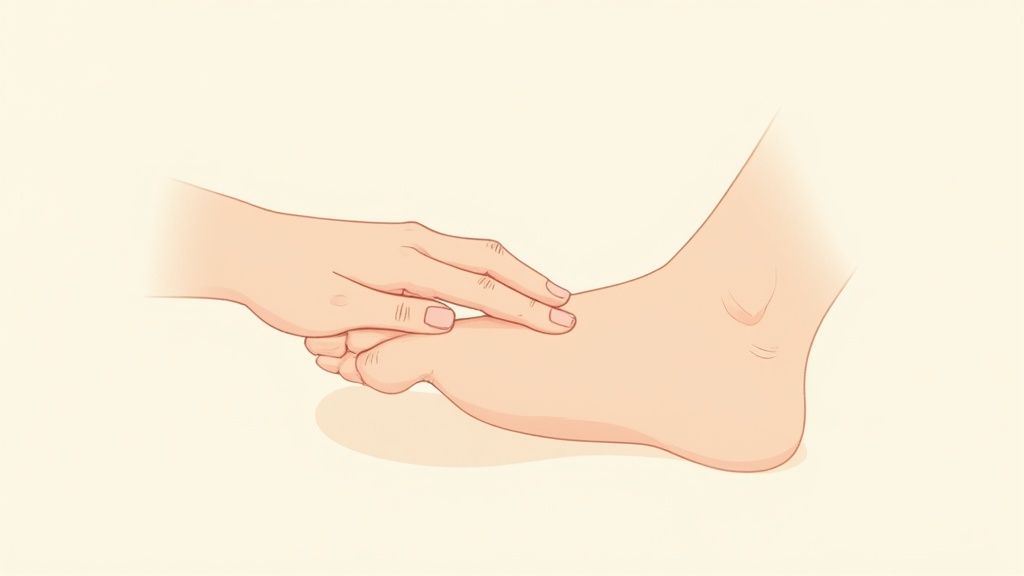 While a hands-on massage is great, your thumbs will eventually get tired. That's where simple, everyday tools come in. They can provide the consistent, deep pressure needed to really get into the fascia and give you lasting relief from heel pain.
While a hands-on massage is great, your thumbs will eventually get tired. That's where simple, everyday tools come in. They can provide the consistent, deep pressure needed to really get into the fascia and give you lasting relief from heel pain.
You don't need to buy expensive equipment. The most effective tools are often things you already have around the house. Learning to use them correctly turns your self-massage routine from good to great.
The Massage Ball Technique
One of the most effective tools I recommend is a small, firm ball. It’s simple, but it works. A tennis ball is perfect if you're just starting out or prefer gentle pressure, while a lacrosse ball will give you a much deeper, more intense massage.
To get started, sit in a chair, place the ball on the floor, and gently roll your foot over it from heel to toe. The idea here is to map out the bottom of your foot and find those tender spots.
When you hit a particularly tight or sore point, stop rolling. Just let your foot rest on the ball, applying steady pressure for about 20-30 seconds. This isn't about causing sharp pain; it's about holding that "hurts-so-good" pressure to encourage the knot to release. Don't forget to breathe.
Pro Tip: This is a fantastic thing to do first thing in the morning. A few minutes of rolling before you take your first step can make a huge difference in that initial, sharp pain by warming up and loosening the fascia.
The Frozen Bottle for Icing and Massage
Combining cold therapy with massage is a brilliant two-for-one punch against pain and inflammation. All you need is a standard water bottle, frozen solid.
Just place the frozen bottle on the floor and roll your foot over it, much like you would with the massage ball. The cold immediately starts to numb the pain and reduce swelling, while the rolling action helps stretch the fascia.
- How long? Stick to about 5-10 minutes at a time.
- How much pressure? Let the weight of your leg do the work. Don't force it.
- When to do it? This technique is your best friend after a long day on your feet or anytime your heel feels particularly angry and inflamed.
Foam Rolling Your Calves
It’s so easy to focus only on the foot, but here's a secret that many people miss: tight calf muscles are often a huge part of the problem. When your calves are constantly tight, they pull on your Achilles tendon, which then pulls on your heel bone and puts enormous strain on your plantar fascia.
Releasing this tension with a foam roller can be a total game-changer. Sit on the floor with your legs out in front of you and place the roller under one of your calves. Prop yourself up with your hands.
Slowly roll from your ankle up to just below the back of your knee. When you find a sore spot—and you will—just pause on it for 20-30 seconds and let the muscle relax. Adding this to your routine addresses a major source of the strain, often providing more relief than just working on the foot alone.
Comparing Massage Tools for Plantar Fasciitis
To help you choose the right tool for the job, here’s a quick breakdown of the most common options. Each one has its own unique benefits, and you might find that you use different tools on different days depending on how your foot feels.
| Tool | Primary Benefit | Best For | Pro Tip |
|---|---|---|---|
| Massage Ball | Targeted, deep pressure | Releasing specific knots and trigger points | A lacrosse ball offers more intensity than a tennis ball for deeper work. |
| Frozen Bottle | Combines cold therapy and massage | Acute flare-ups with pain and inflammation | Keep a dedicated bottle in the freezer so it's always ready to go. |
| Foam Roller | Addresses calf muscle tightness | Relieving the root cause of fascial strain | To increase pressure, cross one leg over the other to add weight. |
| Your Hands | Precision and sensory feedback | Gentle warm-ups and exploring tender areas | Use your thumbs to apply pressure and your fingers to feel for tight bands. |
Ultimately, the best tool is the one you'll actually use consistently. Experiment with each of these to see what gives you the most relief and feels best for your body.
Advanced Massage Methods for Stubborn Pain
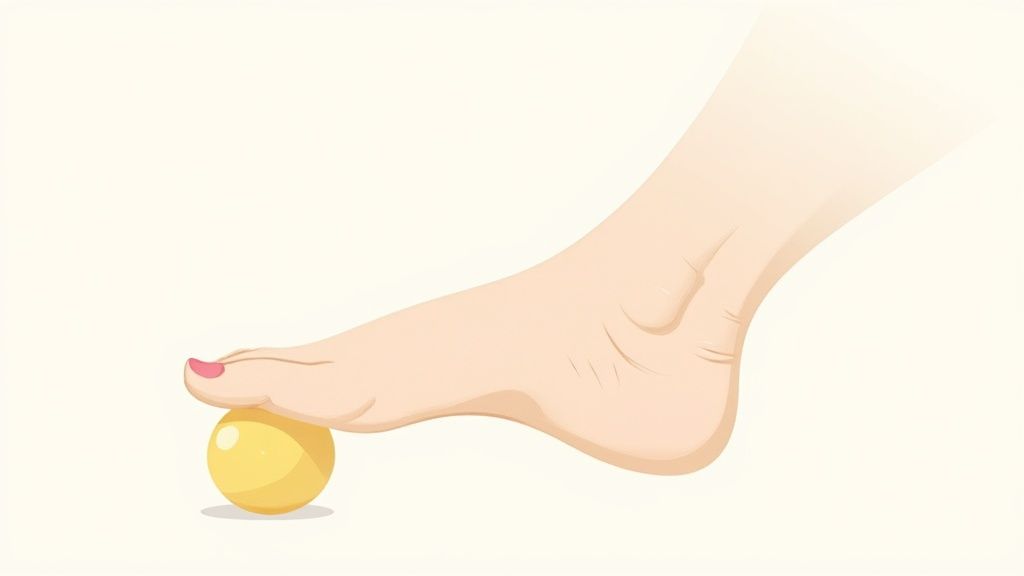
When that nagging heel pain just won’t let up, it might be time to look beyond the usual fixes. Sometimes, plantar fasciitis is more than just general inflammation; it's caused by stubborn muscle "knots" and tight, restricted tissue that need a more targeted approach.
These next-level massage techniques are what I’ve seen therapists use for those really persistent cases. They do require a bit more focus and a lighter touch than a simple foot roll, but they can make a world of difference when you feel like you've stalled out on your road to recovery.
Releasing Trigger Points in Your Calf and Foot
You've probably heard of trigger points. They're those super-sensitive spots in a tight muscle band that can shoot pain to a totally different area. When it comes to plantar fasciitis, these sneaky knots aren't just in your foot—they're often hiding in your calf muscles. Releasing them can finally ease the constant pulling on your heel.
- How to find them: Sit down and gently feel around your calf muscles (both the big gastrocnemius and the soleus underneath). You're searching for small, rope-like spots that feel incredibly tender. A real trigger point might even send a jolt of sensation down toward your foot when you press it.
- The technique: Once you've located a spot, apply direct, steady pressure with your thumb. Go easy here. You're aiming for a discomfort level of about 5 or 6 on a 10-point pain scale. Hold that pressure for 30 to 60 seconds until you feel the knot start to soften or "melt" under your thumb.
This isn't just theory; it gets results. A 2021 case study showed that trigger point therapy on the lower leg and foot dramatically cut heel pain and improved a patient's mobility in just five weeks.
Using Gua Sha to Break Up Adhesions
Gua Sha is an old-school technique that involves gently scraping the skin with a smooth-edged tool. This might sound strange, but it's fantastic for breaking up fascial adhesions—think of them as tiny bits of scar tissue—and boosting circulation to kickstart the healing process. You can buy a special Gua Sha tool, but honestly, the rounded edge of a ceramic soup spoon works just fine.
A Quick Word on Safety: Always use some lotion or oil so the tool can glide without friction. The idea is to create some temporary redness (called "petechiae"), not to cause bruises or break the skin.
Relax your foot and use gentle but firm strokes with your tool. Always move in one direction, from your heel up toward your toes. Pay special attention to the inner arch, where that plantar fascia ligament is thickest. It's a unique sensation that's great for releasing tightness close to the surface.
After a good massage session, you might want to give your foot some extra support. You can learn more about that in our guide on how to tape a foot for plantar fasciitis.
Gentle Positional Release
This last technique is the complete opposite of deep pressure. Instead of forcing a muscle to relax, you're gently coaxing it.
Start by finding a tender spot on the bottom of your foot. Rather than digging in, gently flex, extend, and rotate your foot and toes. The goal is to find the one position where that tender spot feels totally comfortable and pain-free.
Once you find that position of ease, just hold it. Don't move. Stay there for about 90 seconds. This simple act gives the nerve endings in that muscle a chance to reset, sending a signal that it's safe to let go of the tension. It's a surprisingly powerful way to calm down those acutely painful spots without making them angrier.
Building a Consistent Massage Routine for Recovery
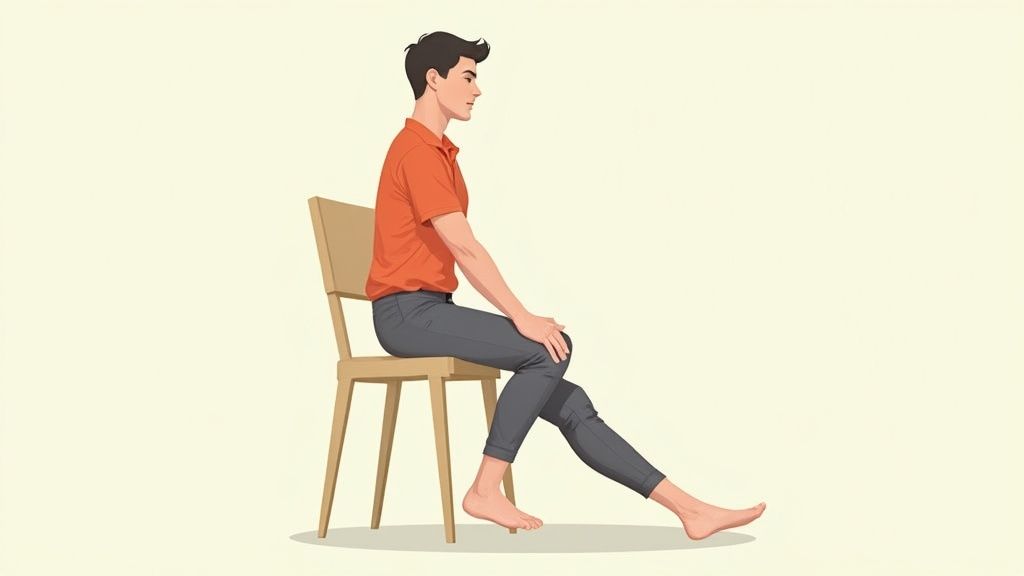 Knowing a few good plantar fasciitis massage techniques is a great start, but it's only half the story. The real key to getting lasting relief is consistency. An intense, hour-long massage once a month just can't compete with spending a few gentle minutes on your foot every single day.
Knowing a few good plantar fasciitis massage techniques is a great start, but it's only half the story. The real key to getting lasting relief is consistency. An intense, hour-long massage once a month just can't compete with spending a few gentle minutes on your foot every single day.
The goal here is to create a habit that helps you heal without accidentally making things worse. Think of it as a small, daily investment in getting back on your feet, pain-free. Instead of trying to carve out a huge chunk of time, just weave these massages into the things you already do.
Creating a Simple Daily Schedule
A good routine doesn't need to be complicated. In fact, it's better if it's simple—that way, you'll actually do it.
Here are a couple of practical ways to fit massage into your day:
- The Morning Kickstart: Before your feet even hit the floor, give them a gentle stretch. Then, while your coffee is brewing, roll your foot over a frozen water bottle for about 5 minutes. This is a fantastic way to wake up the fascia and calm inflammation before those dreaded first steps of the day.
- The Evening Wind-Down: As you're relaxing on the couch watching TV, take 10 minutes for a hands-on massage. Gently work through those heel-to-toe glides and thumb presses. It feels great and helps undo the aches and pains from the day.
This simple one-two punch of morning and evening care creates a powerful healing rhythm. You're tackling both the morning stiffness and the end-of-day soreness, giving that tissue a chance to recover around the clock.
The best massage routine is the one you actually stick with. When it comes to healing the plantar fascia, consistency is always more important than intensity.
Listening to Your Body
It's so important to learn the difference between a "good hurt" and actual pain. A productive massage might feel a bit uncomfortable, like you're working out a stubborn knot. But if you feel any sharp, shooting, or radiating pain, that's your body telling you to stop. You're pushing too hard.
Being too aggressive, especially when your foot is already flared up, can just make the inflammation worse and set you back. If you notice your pain is worse the next day, give your foot a break and try again later with a much lighter touch.
If you’re wondering which technique is best, the research points to consistency being the most important factor. A 2023 study, for example, showed that methods like Gua Sha and ice massage (cryostretch) dramatically improved pain and function after just seven straight days of use. You can read more about these manual therapy findings on PMC.
Ultimately, if you’ve been diligent with self-care for a few weeks and aren't seeing results, it’s probably time to talk to a professional. For more ideas on what to try next, take a look at our guide on what to do for plantar fasciitis.
Got Questions About Plantar Fasciitis Massage? Let's Clear Things Up.
When you first start massaging your feet for plantar fasciitis, a bunch of questions usually come to mind. It’s totally normal to wonder if you’re doing it right and not accidentally making things worse. I've heard these same concerns from countless people over the years, so let's tackle them head-on.
How Often Should I Be Massaging My Feet?
When it comes to healing, consistency is everything. A good rule of thumb for most people is to aim for a 5 to 15-minute massage session, once or twice a day.
Think of it this way: a quick session first thing in the morning can really help with that awful morning stiffness, making those first steps out of bed far less painful. Then, another round in the evening can soothe away the day's accumulated aches.
The most important thing is to listen to your body. If you notice more pain, that’s your cue to ease up on the pressure or maybe skip a session. The goal here is steady, gentle progress, not forcing the issue.
Should This Massage Hurt?
This is a big one, and the answer is nuanced. You should expect to feel some mild discomfort or tenderness, especially when you find a really tight spot or a knot. Many people call this a "good hurt"—it feels productive and relieving, not genuinely painful.
What you should never feel is sharp, shooting, or intense pain. If that happens, stop. You're pushing way too hard. Your guide should always be "firm but comfortable." The pressure needs to be enough to release tension, but not so much that you're wincing or tensing up your muscles, as that can just make the inflammation worse.
Here's a great way to check yourself: On a pain scale of 0 to 10 (where 10 is the worst pain you can imagine), the discomfort during your massage should never climb past a 4 or 5.
Is It Possible to Make My Plantar Fasciitis Worse with Massage?
Unfortunately, yes. If you’re not careful, it is possible to aggravate the condition. The two most common mistakes I see are going too deep and aggressive right on the most painful spot (especially during a flare-up) or just massaging for too long. This can easily ramp up inflammation and send you backward.
To keep that from happening, just stick to these simple rules:
- Warm up first. Always. A warm foot soak or even just doing some gentle ankle circles gets the tissue ready and makes the massage more effective.
- Start with a light touch. Ease into every session with gentle strokes before you even think about applying deeper pressure.
- Work the entire area. Don't just zero in on your heel. You'll often get better (and safer) results by massaging your whole arch and, crucially, your calf muscles.
If your foot feels noticeably worse the next day, that's a clear sign. Take a day off from massage, and when you try again, use much, much less pressure.
When Is It Time to See a Doctor or Physical Therapist?
Self-massage is a fantastic tool, but it has its limits and isn't a replacement for professional medical advice. You should absolutely book an appointment with a doctor or physical therapist if you run into any of these situations:
- The pain is severe or seems to be getting worse, not better.
- You've been consistent with self-care for a few weeks with no real improvement.
- Your pain started suddenly after a specific injury, like a fall or a misstep.
- You notice any signs of infection, like redness, swelling, and the area feeling warm to the touch.
A healthcare professional can give you a proper diagnosis to make sure it isn't something else, like a stress fracture. They can also get you started on a complete recovery plan with targeted exercises and stretches that go beyond what massage alone can do.
Don't let foot pain dictate your life. While these massage techniques can bring welcome relief, giving your feet the right support throughout the day is a game-changer. Samurai Insoles are designed to help correct overpronation and cushion your feet with every step, making them the perfect partner in your fight against plantar fasciitis. See what a difference they can make by visiting samuraiinsoles.com.
